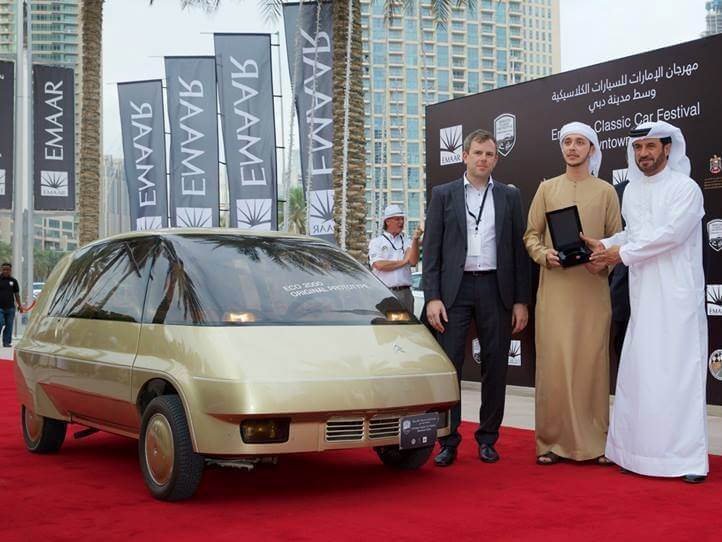The Seventh edition of the Emirates Classic Car Festival was organized from March 19 to 22, 2015 by Emaar Properties in association with the Automobile & Touring Club of the UAE (ATCUAE), with the support of Ministry of Culture, Youth & Community Development and the Roads & Transport Authority. The Emirates Classic Car Festival is regarded as the Middle East’s premier showcase of classic cars.
We would like to congratulate our close friend with winning its class with the 1982 Citroën ECO 2000, Prototype SA 103. We bought this car from Citroën Heritage in 2014. After acquisition we prepared the car because it was on showdisplay for many years. When this was finished, the car was directly shipped to Dubai. The award was presented by the Festival’s President, famous rallydriver, Mohammed Bin Sulayem.
The Citroën ECO 2000
The Citroën ECO 2000 was much more than just an exercise in styling. Developed during the period 1981 to 1984, it was used to research economical, low weight, low drag cars intended for the next millennium. Many of the lessons learned were applied to the forthcoming Citroën AX. ECO 2000 was part of a 50% French State funded programme to build a car capable of achieving 2 litres per 100 km fuel consumption. A hundred engineers at Peugeot-Citroën took part in the research.
A number of different scale models were built and tested in a wind tunnel resulting eventually in a vehicle with a Cd factor 0,22. Three prototypes were built: the SA 103, SA 109, SA 117 and latest the SL 10, the definitive version.
SL 10 weighed 450kg and was powered by a three cylinder 750 cc engine developed from Fiat’s Fire 1000 developing 35 bhp at 4.750 RPM. The first prototype (SA 103) employed a rear mounted twin cylinder engine but subsequent versions had the engine mounted at the front and front wheel drive.
Suspension was hydropneumatic with electronically controlled, speed sensitive ride height. Top speed was 140 KM/H and overall fuel consumption at 3,5 litres per 100 km missed the target. However, the car managed 2,1 litres per 100 km at 90 KM/H while managing to cover the standing kilometre in 40 seconds.
The prototype SA 103 was the first in the series. According to Citroën, it was the “initial synthesis of theoretical work undertaken, focusing principally on weight and aesthetics. The desire not to exclude any potential solution is illustrated through the use of the “propulsion” type architecture. In order to save time, the flat twin-cylinder engine was retained. The car weighs just 430 kg, with a drag coefficient of 0.267 and fuel consumption of 3.5-litres per 100 km. The 704cc engine develops 26 bhp and the car has a top speed of 140 KM/h.
